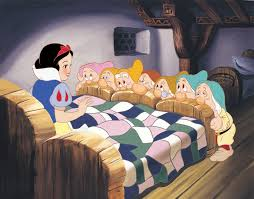Posted by Sarah
Discussion prompted by the screening of Snow White and the Seven Dwarfs (1938) touched on several areas: the definition of melodrama (especially the use of music and the theme of suffering); early film melodrama; stage melodrama; the relationship between animation, realism and melodrama. Do leave comments or email me at sp458@kent.ac.uk to add your thoughts.
Music played a more significant role in Snow White than the other films the group has watched so far.It also worked in an especially interesting way, given the fact that the term ‘melodrama’ means drama with music. While there were instances of dramatic music accompanying moments of increased tension, at times the music was upbeat even though the themes were dark. This is evident especially at the film’s beginning when the cheerful music belies the tale of ‘Once Upon a Time’ woe the open book is relating to us. It was generally thought that this was likely to be related to Disney’s need to reassure the audience that all would end happily.
This constant presence of light amidst the darkness was seen to relate to the theme of suffering, which often plays a central part in melodramas. In Snow White the suffering is largely restricted to the arguably less central characters: the dwarfs and the woodland creatures who are distraught when it is thought Snow White has died. Snow White herself is chirpy throughout. Although she enters dressed in rags she is happy with her lot. It is only the threat on her life and her subsequent terrifying walk through the woods which stirs up emotions of fear. This was perhaps partly due to the animation style for the different characters. While the dwarfs and the Evil Queen/Old Pedlar Woman were shown to be remarkably expressive, Snow White’s face appeared less animated.
It was also remarked upon that Snow White’s dark hair might oppose the usual representation of virginal purity associated with blondness. The scene in which the dwarfs and woodland creatures ride to Snow White’s rescue especially highlighted this. It was noted that there were similarities between this and D.W. Griffiths’ Birth of a Nation (1915) in which the rescuers race to save the blond and virginal Lillian Gish.
However late Victorian stage melodrama focused on blond villains and dark-haired heroes and heroines so it is possible that Snow White was drawing on earlier stage productions. The links to stage melodrama were found to be especially interesting. While Snow White is an unusual heroine for a film melodrama (and probably even stage melodrama), her evil stepmother, the villainous queen, contains the traits often associated with melodrama, especially its archetypes. Her theatrical gestures and swishing of her cloak or cape seemed very in keeping with general ideas of the villain in melodrama. As is her ability to dupe the hero (in this case heroine) with ease. Such archetypes formed the basis of such traditions as pantomime, fairy tales and melodramas but it was thought that the particular way in which they were used was important. Although pantomime and melodrama can share a use of comic relief characters (such as the dwarfs in Snow White) its focus on the sensational sets it apart. In Snow White the sensational was emphasised particularly in terms of atmosphere – thunder and lightning etc.
A broader point that the very nature of animation and that of staging had important similarities was also raised. Arguably both are less able to work in several dimensions, with characters generally populating the foreground. The dramatic closing of curtains and the Old Pedlar Woman’s appearance framed by a window in which she appears to almost address the audience (see the picture advertising the screening) also linked the film to theatrical productions.
The importance of the fact Snow White is an animated film was also related to the notion that melodrama is anti-realism in nature (see Christine Gledhill in Home is Where the Heart Is (1987)). The distancing from reality arguably achieved by animation would seem to suggest that animation with its ability for exaggeration is well suited to depicting melodrama. This might be an interesting area to explore further, perhaps especially in relation to Disney.
Many thanks to Ann-Marie for selecting a wonderful film which led to so much fruitful discussion.


After a little more research I discovered a few more interesting points:
They used a technique called rotoscoping for some of the animation of the human characters. This allows them to directly trace human movements, and is not used to such an extent today. In this it was used for the Prince and Snow White.
Frank Nugent of the ‘The New York Times’ claimed ‘It is a classic, as important cinematically as “The Birth of the Nation.”‘ (Gabler, p.273) So it is interesting that we made that comparison in the discussion. Walt made his artists watch films to gain perspective and direction, perhaps even gained ideas from films such as this, hence the similarity?
I also think it is interesting how he was influenced by the Grimm fairy tale, (reportedly) a stage play, and a silent film that he watched as a boy with four screens playing simultaneously. Thus, this film becomes a mix-match of personal influences. What is apparently new to all of them is the true love’s kiss. In the original story the apple dislodges from her throat when the coffin is moved, thus, it seems this kiss is more melodramatic, albeit fantastical. It could also suggest an awakening to womanhood, I’m sure there is much sexual subtext in this film.
Also, like we mentioned in the discussion it is humorous that Walt aimed for realism, whereas in fact animation is anti-realism. Disney even went to the extent to change the colour palette from bright to a chiaroscuro effect.